The strength and stiffness of material are two crucial properties to understand in the evaluation of products. They play a major role in determining the application of materials for different purposes. Some applications require products that need to be strong and resist bending. Such products must also be able to distribute the load over a required area.
Oftentimes, people confuse these properties as the same. Many people also confuse both concepts with the hardness of materials. However, there exist several differences between them. Therefore, it is crucial to understand these differences while choosing material for various purposes.
This article explains the difference between strength and stiffness and their technical properties. It also provides tips on creating perfect designs using stiff and strong materials. Let us dive right in!
Stiffness vs. Strength
Stiffness and strength are closely related. As such, they are easily confusing terms when it comes to engineering. Their usage in common speech makes it difficult for most people to understand their distinction. This also makes it quite difficult to classify them accordingly. Although they both imply a sense of resistance, stiffness varies from strength in quite a number of ways.
What is Strength?
Strength is a measure of the amount of stress a material can withstand without breaking. This is the ability of the material to support maximum load before it breaks or is permanently deformed.

When a material is deformed, it changes in shape in response to the force applied. Strength, therefore, refers to the ability of a material to accommodate a force without breaking.
It is a total measure of the capacity of the material to withstand the load placed on it before reaching the point of permanent deformation. Engineers often associate a value known as Yield Stress “σy” as strength. This helps to establish the difference between strength and stiffness. The strength of a material is a result of its chemical composition and heat treatment.
Types of Strength
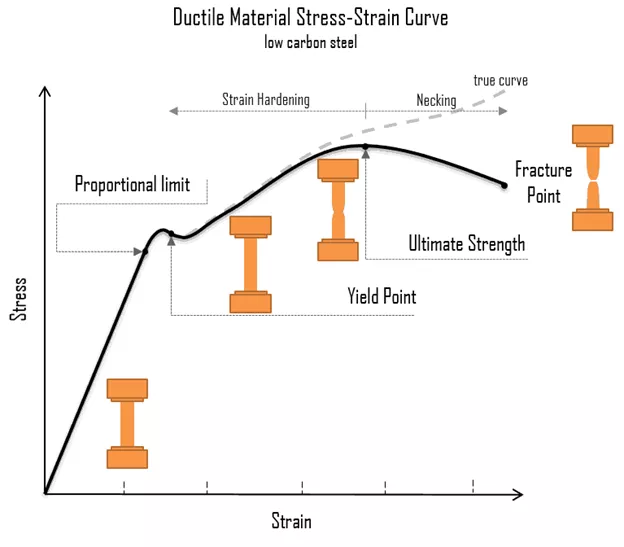
There are various types and measures of strength to check when evaluating materials. They include the following:
Tensile Strength
This is the maximum amount of stretching or pulling a material can take before it becomes damaged permanently. Tensile strength is essentially a measure of how much the material can resist. It is a useful point of reference for how parts will perform in applications.
There are three major types of tensile strength, including:
- Yield Strength. This is the point at which the material starts to deform plastically.
- Ultimate Tensile Strength. This is the ultimate or maximum stress that a material can resist without breaking.
- Breakable Strength. This describes the strength coordinate on the strength-strain curve at the point of breakage.
Impact Strength
Impact strength is a measure of the amount of impact or applied force material is able to take before deformation. The load that causes the impact and the material’s limit are expressed in terms of energy. Therefore, impact strength measures the level of energy a material can take before it deforms.
Compressive Strength
As implied by the name, compressive strength is the maximum level of compression or pressure a material can withstand. It is measured using a universal testing machine. This machine applies a high amount of load to the material.
Yield Strength vs Ultimate Strength
As the name implies, yield strength is the maximum amount of load a material can take before it begins to yield and permanently deform. At this point, the material deforms when there is an exertion of the highest force to reach the yield point.
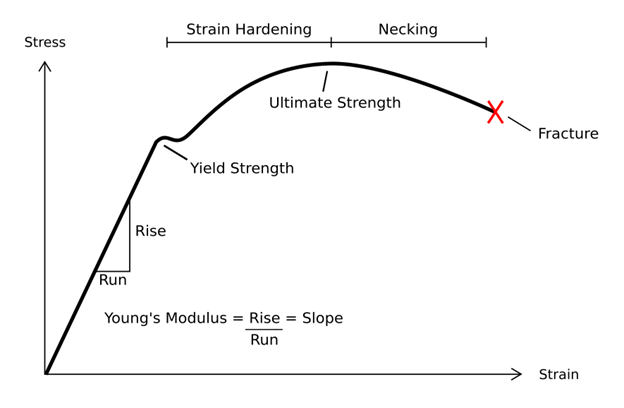
On the other hand, ultimate tensile strength refers to the maximum amount of stress a material can withstand while being stretched. The ultimate tensile strength is the highest resistance of the material to the exerted force. It often results in the permanent elongation or stretching of the material.
However, both yield strength and ultimate tensile strength are indicators of a material’s ability to resist deformation.
What is Stiffness of Material?
Stiffness of material is the measure of a material’s ability to return to its original form after being acted on by an external force. It refers to the material’s ability to resist external forces and still return to its original form.
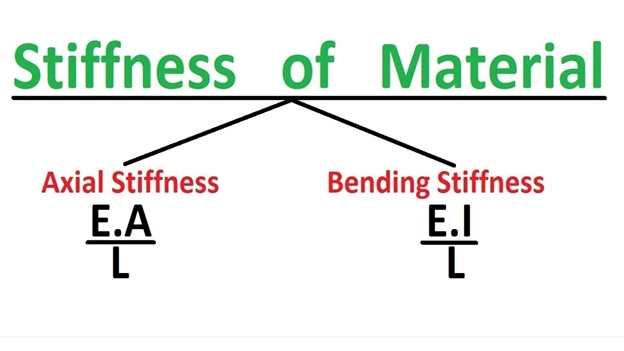
These forces include bending, stretching, and other forms of strain. It can also be referred to as the rigidity of a material. This is its ability to resist deformation. Stiffness is closely related to elastic or flexible materials. The more flexible a material is, the lesser the stiffness.
In general, stiffness is the total measure of the amount of deflection caused by the load on the material. Engineers often associate a value known as Young Modulus “E” for Stiffness.
Knowing the properties of materials is important for your part design. If you need any suggestions about the material selection to create high-quality parts, RapidDirect is your best partner.
Relationship Between Stiffness and Strength
When it comes to stiffness vs. strength, it is easy to confuse things. It often appears to logic that if a material is stiff, it is strong enough to withstand force and support load without breaking. However, this is not the case as “stronger” does not necessarily mean “stiffer.”
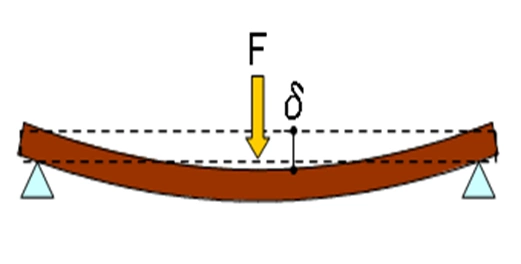
A material’s strength and its stiffness properties are not directly related. This is evident when these materials of varying stiffness and strength properties are exposed to external forces. The properties of the stiff material may allow it to return to its original shape after taking on several forms to take on the force.
On the other hand, a strong material does not change its form. It either resists the force, or it deforms permanently if the force is greater than its tensile strength. This can be confusing to mere logic because resistance to physical deformation is a key part of defining both strength and stiffness. However, the material can break easily if it has low strength. If it has low stiffness, it can deflect a high load.
What Is the Difference Between Strength and Stiffness of Material?
Strength and stiffness are two physical properties of a material. One major difference between them is that stiffness is the ability of an object to withstand stress without breaking. On the other hand, strength is the ability of an object to resist deformation when stress is applied.
Strength measures the stress or force applied to a material before it breaks (tensile strength) or permanently deforms (yield strength). However, stiffness of material defines how a material bends to resist exerted force while returning to its original form upon removing the force.
A strong material with less stiffness will break if the exerted force exceeds its tensile strength. The strong material does not change its form. If the exerted force exceeds its strength, it simply breaks, completely losing its original shape.
However, stiff material with less strength will deflect. The deflection helps it to accommodate the force exerted on it. Therefore, it can return to its original shape once the force is removed.
Best Practices in Designing for Strength and Stiffness
Stiffness vs. strength presents an important topic for consideration in manufacturing. Here are four best practices to keep in check before and throughout a design process.
1. Calculate the Expected Stress on Each Material
To ascertain where setbacks may arise, you must determine the expected force to be exerted on each material. It is important to know how to test the stiffness of material. You can do this by measuring how the intended design responds to varying forces. To examine this, you may employ instrumentation techniques to predict the model behavior and analyze the resultant data. Furthermore, you must note creep and fatigue variables in alternate systems affiliated to the environment the material would be exposed to.
2. Run Tests on A Range of Materials Before Selection
Materials with known mechanical properties should be employed to test for strength or stiffness with the external force. Materials like ceramics are brittle. They do not exhibit any deformation before fracture. Upon the exertion of force, they break rapidly and become deformed permanently. Metals, on the other hand, possess ductile and brittle properties. If ductile, they exhibit plastic deformation before fracture. The brittle alternatives become permanently deformed upon the exertion of force beyond its yield point
3. Identify Important Factors as You Begin Your Design
It is important to identify factors and components that would be most important to your design. These factors may include uniform and impact loading as well as constant and concentrated loads. This is especially crucial at the beginning stage of your design when developing your design with CAD software. This will help you create graphical representations of those components using block diagram modeling and bond graphs. Therefore, you will have a hint of the stiffness and strength required.
4. Confirm the Design’s Functionality Before Prototyping
You can consult with engineers to review your design. They will help you provide technical analysis of your design and provide reviews where necessary. Take advantage of FEA analysis to optimize the geometry of your design. Then, ensure that the numerical results are in sync before prototyping.
Conclusion
It is important to understand the individual roles of strength and stiffness of material in foundational decision-making. They are highly essential factors in the production of high-end products. This is because the production depends on the materials’ response to applied force or load.
The most reliable way to understand the difference between strength and stiffness is to work with a reliable company. At RapidDirect, we understand the interactions between different product designs and materials. We also understand how these materials interact with the ground as well as equipment loads.
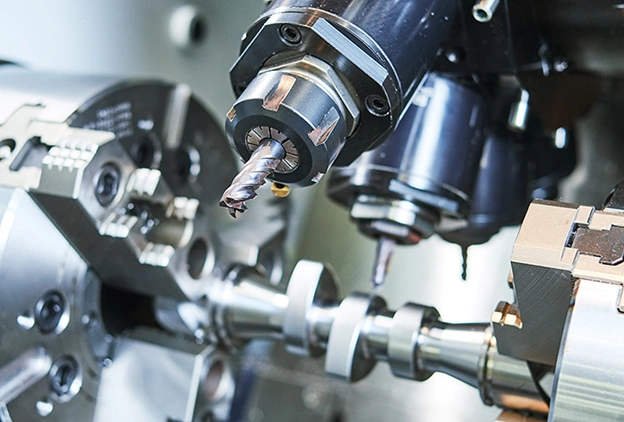
Therefore, we are ready to use our expertise and experience to assist you through the production of your materials. RapidDirect helps you from material selection and purchase to prototyping and production manufacturing. We offer material certificates, ISO 9001:2015 certification, and robust quality inspection. All of these, and more, are available at a competitive rate.


